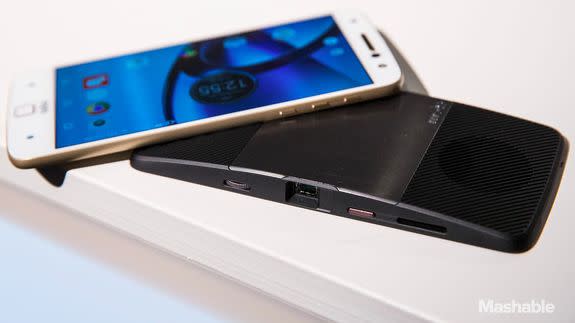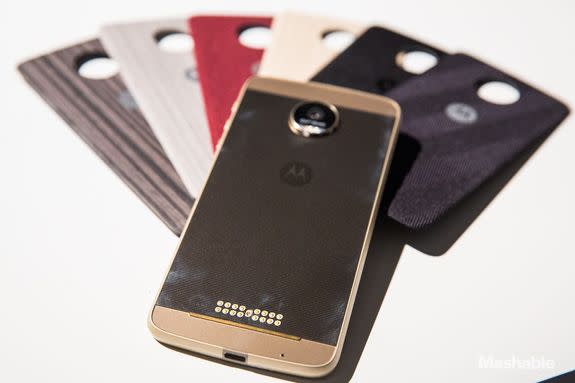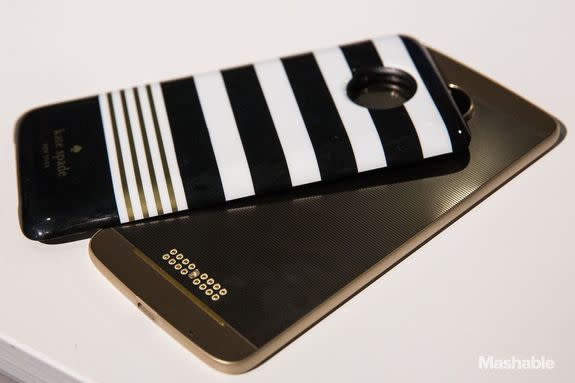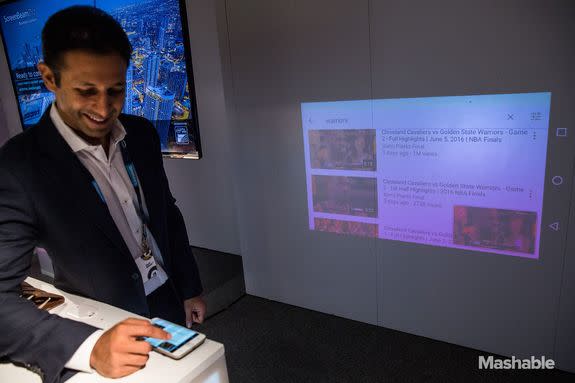Motorola's aiming big with its ambitious modular smartphones

A couple weeks before Lenovo Tech World, Motorola caused a stir when it teased the event with a video celebrating the Razr —leading to much speculation the company was planning to revive the flip phone.
That, of course, turned out not to be the case. Instead, we got a look at two new phones. But Motorola's reference to the Razr — one of its most popular handsets ever — is indicative of how it sees its latest pair of flagships, the Moto Z and Moto Z Force.
SEE ALSO: Motorola ditches headphone jacks before Apple with the Moto Z
As iconic as the Razr was, Motorola is hoping its latest set of devices, which promise to be the first true modular smartphone platform, will become equally so. That's an ambitious goal, to be sure, but the Moto Z and Z Force are also incredibly promising.
The Moto Z comes in two variants: the ultra-thin Moto Z and the thicker, but slightly more powerful, Moto Z Force. Both support Motorola's modules, both feature extremely rapid charging — squeezing hours of battery life out of only 15 minutes of charging, according to Motorola — and both have 5.5-inch display. But the Z Force has a larger battery (that charges faster), a better camera (21MP, compared with 13MP on the Moto Z) and sports a "shatterproof" display. It's also considerably thicker than the 5.2mm Moto Z.

Image: Andrew Burton for Mashable
Those are all neat specs and both the Moto Z and Z Force would be impressive on specs alone. But, let's be clear, the specs are not why you'll buy these phones. The standout feature — and the one Motorola is betting will be a game-changing one — is its modularity. It has swappable accessories, called Moto Mods, that supercharge the devices with extra features.
Motorola showed off three of its own Moto Mods: a speaker accessory, a battery pack and a projector that allows you to watch videos from your device on the surfaces around you. The company is also opening it up to developers and other partners to create their own modules (and incentivizing them with a $1 million prize.) These modules will be sold separately from the devices, though carriers and retailers could choose to create bundles if they want.
We've seen modular designs before — like Google's Project Ara and LG's G5 — but both of those are essentially prototypes at this point (though Google says it plans to have a consumer version ready by 2017.) What Motorola has created is a system that is polished, developer-ready and makes the best case we've seen for modular smartphones.
The modules attach via magnets and are powered by 16 "magic dots" that allow the modules to tap into the phone's core components. Connecting a new module takes seconds and the device provides a bit of feedback (in the form of a vibration) upon a new connection so you know you've attached it properly.

Image: Andrew Burton/mashable
The most impressive part of the modules is how they don't feel gimmicky. They snap on and off easily and don't feel like an afterthought. And they don't make the Z Force or the Moto Z, which is astoundingly thin and light, feel bulky or heavy.
In fact, the 2220 mAh Kate Spade-branded battery pack is one of the thinnest and least bulky battery designs I've seen.

Image: Andrew Burton for Mashable
Better still, the battery — and other modules — can integrate directly with the Android software as well. In the case of the battery pack, this means that you can also see charging information and other data related to the battery (much like Apple's smart battery case.)
Another of Motorola's early partners was JBL, who made a speaker module, which effectively eliminates the need for a separate bluetooth speaker.

Image: Andrew Burton for Mashable
But the most impressive module so far is the Insta-Share Projector, which allows you to turn the surfaces around you into a 70-inch display. It's powered by its own built-in battery, which enables up to an hour of video playback.

Image: Andrew Burton for Mashable
This modular design does come with a couple compromises — most notably the 3.5 mm headphone jack. Motorola eschewed it in favor of the USB Type-C port. (Motorola executives also said the jack would create an "anomaly" in the product shape that would have interfered with modularity.)
We also have yet to find out pricing, which could make or break the line, for either device or the modules. In an interview with Mashable, Lenovo VP Nicklas Jonsson gave a big range for module pricing.
"You can think about anything from $29 to — as innovation goes crazy and you think about narrower and narrower specialized verticals — it could probably run up to 500 bucks. When you start talking about content creation with stereo 360-video camera that works really well in virtual reality headsets where you create your own content — that's probably going to cost a little bit more than just $200 to $300."
Both devices go on sale later this year; the Moto Z and Z Force will be available in August from Verizon (with Droid branding) and available more broadly in the fall.
